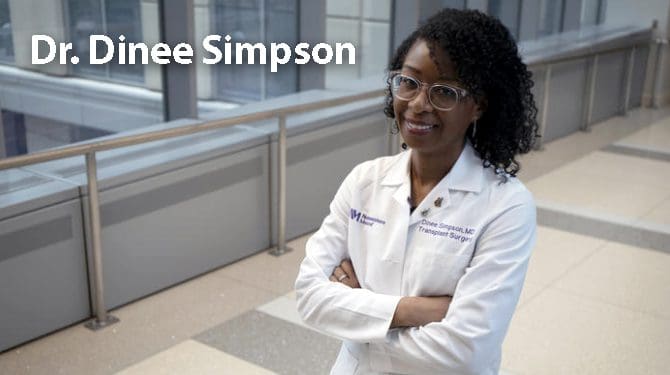Surgeon, Mom, and Liver Champion

Meet Dr. Dinee Simpson – Assistant Professor of Surgery in the Division of Organ Transplantation at Northwestern University, Feinberg School of Medicine.
Surgeon, Mom, and Liver Champion
Dr. Simpson is a decorated surgeon, a loving mother, wife and a fierce advocate for liver patients in underserved communities. In 2019, she created the Northwestern Medicine African American Transplant Access Program (AATAP), an initiative of the Northwestern Medicine Comprehensive Transplant Center. Their mission: to eliminate transplant disparities for underserved residents of the greater Chicagoland area in relation to transplant care for kidney and liver disease. Dr. Simpson currently serves on ALF’s Medical Advisory Council in Chicago.
According to Dr. Simpson, “Professionally, I am most proud of the AATAP. It is a comprehensive program that attempts to level the playing field when it comes to access for transplantation by lessening the disparities for Black patients. There have been several studies published that demonstrate the inequities Black patients face when trying to access the transplant process.”
“Here in Chicago, we published data showing that compared to White patients, Black patients are less likely to be listed – or transplanted – and have a 26% increased hazard of liver-related death. Many of the factors that lead to these disparities can and should be modified. There needs to be systemic change to really get to the root of the problem and we should all push for that,” added Dr. Simpson.
Fast Facts on Transplant
- A liver transplant is recommended when a person’s liver no longer functions well enough to keep them alive.
- In the U.S., more than 106,000 people are waiting on a transplant right now, nearly 12,000 of whom are liver patients.
- According to the Organ Procurement and Transplantation Network, in 2021, 9,236 liver patients received a life-saving transplant, but only 524 transplants came from a living donor.
- Many people on the transplant wait list won’t receive a transplant in time because there aren’t enough deceased donor livers available.
- But there is another option: living donation.
- During a living-donor liver transplant a portion of the liver from a healthy donor is removed and transplanted into the recipient.
- These transplants are possible because of the liver’s unique ability to regenerate or regrow.
If you or someone you love needs help finding a living donor, let the American Liver Foundation help. We have a free living donor liver transplant resource center with information on living donation process including a recipient guide and donor guide to living donor liver transplant and a comprehensive toolkit to help get you started! Plus, more resources to better help you understand the living donation process.
“Some may call me a crazy cat lady”
When Dr. Simpson isn’t busy saving lives and advocating for change, you can find her at home tapping into her creative side with family. From costumes and cakes to “Caturday” tweets with her sons about their two cats, Uxie Powderpuff and Rocky Dangerbuff, Dr. Simpson finds joy in creation and the joy it brings to others.
Thank you, Dr. Simpson for being a champion for all people affected by liver disease. This month as we celebrate Black History Month, we celebrate and honor YOU!
Last updated on August 5th, 2022 at 02:59 pm